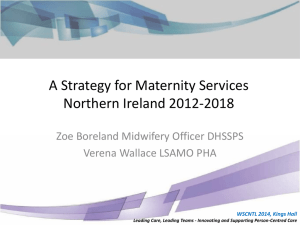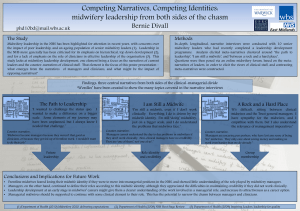Norfolk Health Overview and Scrutiny Committee
advertisement
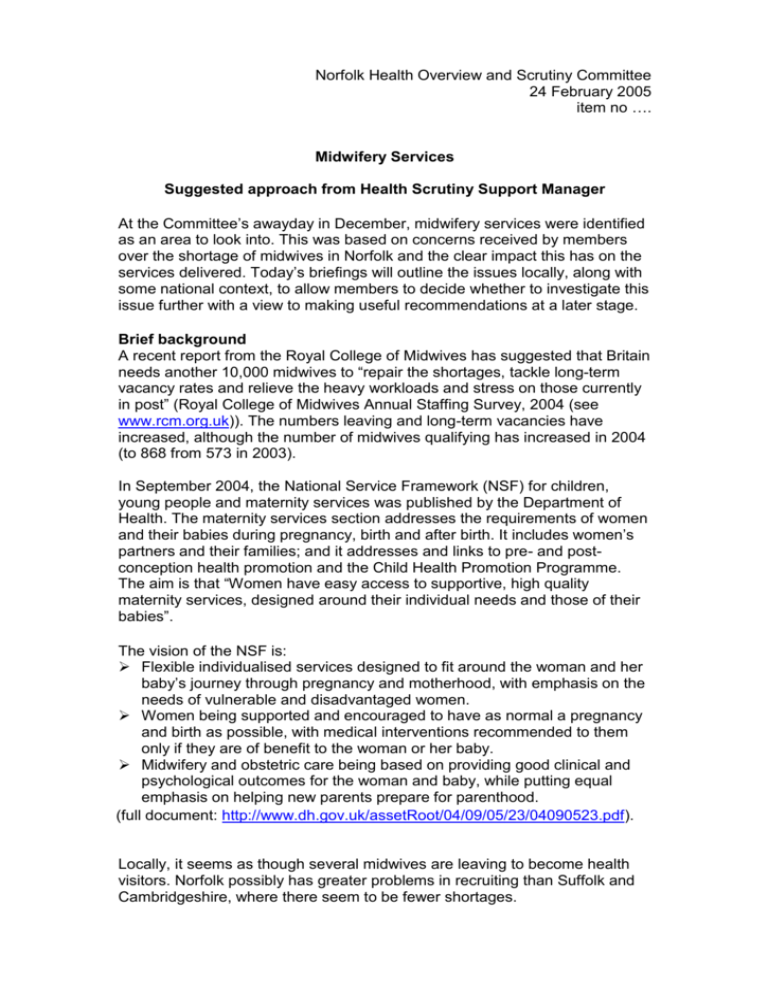
Norfolk Health Overview and Scrutiny Committee 24 February 2005 item no …. Midwifery Services Suggested approach from Health Scrutiny Support Manager At the Committee’s awayday in December, midwifery services were identified as an area to look into. This was based on concerns received by members over the shortage of midwives in Norfolk and the clear impact this has on the services delivered. Today’s briefings will outline the issues locally, along with some national context, to allow members to decide whether to investigate this issue further with a view to making useful recommendations at a later stage. Brief background A recent report from the Royal College of Midwives has suggested that Britain needs another 10,000 midwives to “repair the shortages, tackle long-term vacancy rates and relieve the heavy workloads and stress on those currently in post” (Royal College of Midwives Annual Staffing Survey, 2004 (see www.rcm.org.uk)). The numbers leaving and long-term vacancies have increased, although the number of midwives qualifying has increased in 2004 (to 868 from 573 in 2003). In September 2004, the National Service Framework (NSF) for children, young people and maternity services was published by the Department of Health. The maternity services section addresses the requirements of women and their babies during pregnancy, birth and after birth. It includes women’s partners and their families; and it addresses and links to pre- and postconception health promotion and the Child Health Promotion Programme. The aim is that “Women have easy access to supportive, high quality maternity services, designed around their individual needs and those of their babies”. The vision of the NSF is: Flexible individualised services designed to fit around the woman and her baby’s journey through pregnancy and motherhood, with emphasis on the needs of vulnerable and disadvantaged women. Women being supported and encouraged to have as normal a pregnancy and birth as possible, with medical interventions recommended to them only if they are of benefit to the woman or her baby. Midwifery and obstetric care being based on providing good clinical and psychological outcomes for the woman and baby, while putting equal emphasis on helping new parents prepare for parenthood. (full document: http://www.dh.gov.uk/assetRoot/04/09/05/23/04090523.pdf). Locally, it seems as though several midwives are leaving to become health visitors. Norfolk possibly has greater problems in recruiting than Suffolk and Cambridgeshire, where there seem to be fewer shortages. Issues other than recruitment and retention of staff include increasing expectations on the service, increased ante-natal screening, increased Caesarean and a rise in the number of births during 2003, a trend that is continuing into 2004 (see table below). Maternity Unit 2000 2001 2002 2003 Trend Rosie (Cambridge) Peterborough Ipswich Norfolk & Norwich Hinchingbrooke West Suffolk King’s Lynn James Paget 4516 3320 3456 4819 2246 2255 1973 2003 4520 3303 3190 4397 2142 2255 1925 2011 4563 3304 3174 4604 2147 2318 2021 1979 5067 3427 3456 4801 2181 2431 2019 2132 504 ↑ 123 ↑ 282 ↑ 197 ↑ 34 ↑ 113 ↑ 2↑ 153 ↑ 24,588 23,743 24,110 25,514 1404 ↑ 758 ↓ 845 ↓ 367 ↑ 1404 ↑ Total births Total Rise/Fall The purpose of this session To receive presentations from: Neal Barker, Divisional General Manager, Women, Children & Sexual Health Services; Christine Baxter, Director of Nursing & Education; and Sue Marshall, Head of Midwifery, all from the Norfolk and Norwich University Hospital Julie Lindsay, Lead Midwife for Education/Professional Head, Midwifery, School of Nursing and Midwifery, University of East Anglia. To gain an understanding of the local and national issues facing midwives, patients and the management of the services. To decide whether to pursue any issues in more detail or to ask for further information. Please note: Representatives from James Paget and Queen Elisabeth Hospitals have been invited but were unable to attend this meeting. They have all expressed willingness to help in future meetings should the Committee want to go further. Suggested approach After the presentations, members could ask questions to clarify the issues. Members should decide whether to pursue any issues further. If so, they should decide whether to scrutinise in committee or to set up a working group, bearing in mind the forthcoming elections and pressures on their time.
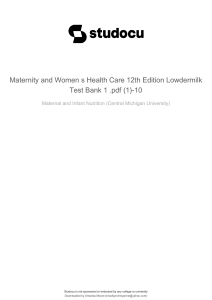

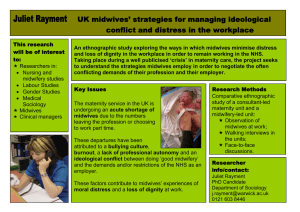
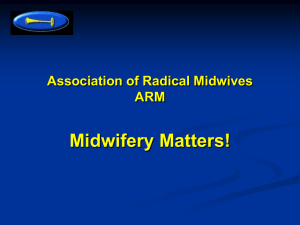

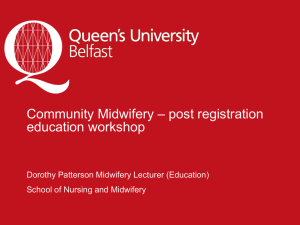


![Letter to MPs re: maternal mental health report Dear [Name of MP] I](http://s3.studylib.net/store/data/006839335_1-7d7b3127aade7ad6d126565942ce75c1-300x300.png)

